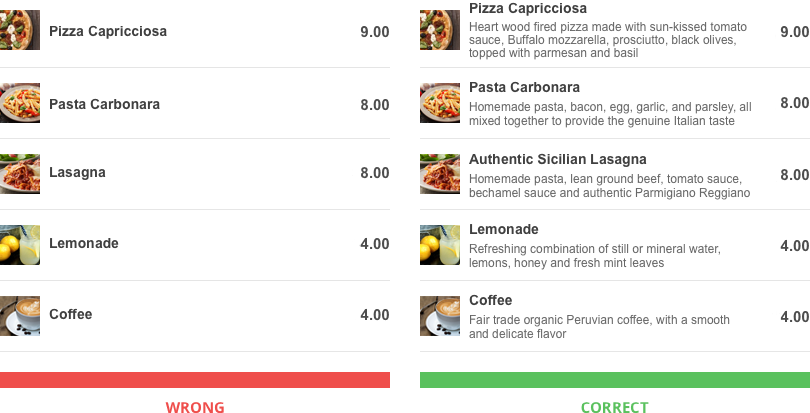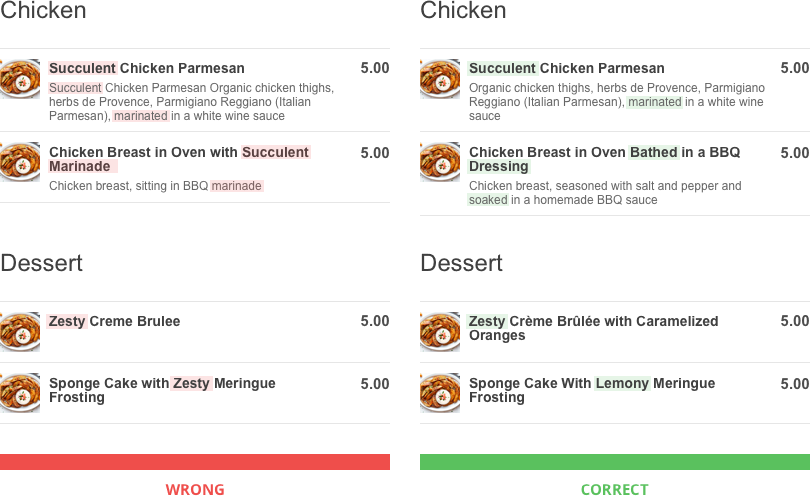Expert Menu Writing Tips & Secrets
- Longer Food Descriptions Sell 30% More Foods
- Use Nostalgia / Emotionally Charged Language to Describe Your Dishes
- Maximize the Diversity of Your Word Choices
In less than 5 minutes from now, you’ll discover how to write a menu card that really sells… how to write the BEST food descriptions that make you hungry (actually that will make virtually anyone hungry).
Do successful restaurateurs rely on menu writing tips & secrets to boost their sales? Of course they do. It’s not just their delicious food that attracts their clients like moths to a flame.
It’s the way their menu is “reinforced” by mouth-watering food descriptions -> which also weighs heavy to their restaurant sales. In fact, did you know that using a carefully crafted menu language can lure and reel in your clients easier than you’d ever thought possible?
Welcome to the third part of the #MenuEngineeringTrilogy, which highlights the persuasion power that language carries.
In fact, there cannot be a trilogy without an article on the fascinating and absorbing art of menu writing, which can easily help you hook your clients. And persuade them to order considerably more food even if they’re full.
This article is the icing to our Menu Engineering formula. And here’s precisely why.
Menu Descriptions Words That Sell
Words can prove vital to achieving your goal, whatever that may be. Because they can captivate, they can influence, and they can even sell. That’s why crafty restaurateurs use creative menu wording… since they are powerful enough to trigger their clients’ emotional response.
And impel them to take action and order more foods from the menu. In fact, researchers at Utrecht University, discovered that
“tempting food words activate simulations of eating the food, including simulations of the taste and texture of the food, simulations of eating situations, and simulations of hedonic enjoyment”
(Papies EK. Tempting food words activate eating simulations. Frontiers in Psychology. 2013;4:838. doi:10.3389/fpsyg.2013.00838)
In layman’s terms that means that upon reading appealing restaurant menu descriptions people actually imagine themselves enjoying that tasty food, they’re reading about.
How to Write a Menu Description: Follow These 3 Steps
So, without further ado let’s skip to the core menu writing ideas YOU should absolutely use in your menu:
#1. Menu Writing Tips: Longer Food Descriptions Sell 30% More Food
Here’s an important trick of the trade. Various studies agree with menu engineers in that one of the best ways to keep your clients satisfied and happy is by writing longer food descriptions.
Take for instance the following menu descriptions examples: “Succulent Italian Seafood Filet” V.S. “Seafood Filet”, which costs, let’s say $13.
The more food descriptions words you include in your menu, the lower the price will seem to your clients. Because they’ll feel that they’ll be getting more value for their money. That they’ll be the ones getting a bargain.
A field experiment conducted by Dr. Brian Wansink, the director of the Food and Brand Lab at Cornell University, discovered the following: Using food description words helped boost sales with 27% more than the same name dishes not accompanied by them.
So try using more of the following menu descriptions words:
- adjectives -> “tender,” “succulent,” “satin”, etc.
- cultural/geographic terms -> “Cajun”, “Italian”, “Spanish”, “Peruvian”, etc.
- and nostalgic terms like “home-style,” “traditional”, “Grandma’s”, etc.
Another great way you can make the most use of this tactic is by adding plenty of ingredients listed under the foods item in your menu. And get this: according to the same Cornell study, customers also rated the more thoroughly described food as being more delicious.
So for example, instead of merely saying “Chocolate cake”, try using some of the following menu descriptions words:
“5-Layer Chocolate Cake – coffee-bathed chocolate gateau, Belgian chocolate filling, fluffy whipped cream and raspberry icing.”
I don’t know about you, but this is just one of the food description examples that can make quite an impression. (I think I’ll head out to the kitchen after writing this piece).
Bonus tip: providing that the following also apply to your foods, you can also use menu writing formulas like:
- “gluten-free”
- “line-caught”
- “farm-raised”
- “locally sourced”, etc.
… which customers absolutely seem to love. Considering all the healthy-eating craze that took the entire world by storm.
So the best way to give your clients a run for their money? Writing more on your menu.
Menu Writing Tips #1:
Longer Food Descriptions Sell 30% More Food

#2. Menu Writing Tips: Use Nostalgia / Emotionally Charged Language to Describe Your Dishes
A nostalgic blast from the past can really help you go a long way with your clients. And as long as you’re using the power of emotional names for your dishes, you can only win.
For example, instead of simply writing “Lasagna” or “Wedges” on your menu, you can go big and use the following menu writing samples:
“Grandma’s Lasagna Recipe”.
“Traditional Sicilian Wedges”.
Coming up with creative ways of reminding them about things they care about most – like their family or their origins – is essentially a powerful selling method in itself. What you should always remember is: People make buying decisions based on their emotions, even though they justify them with logic and reason.
Menu Writing Tips #2:
Use Nostalgia / Emotionally Charged Language to Describe Your Dishes

#3. Menu Writing Tips: Maximize the Diversity of Your Word Choices
Persuasion is strongly related to lexical diversity. But what does that mean exactly? Well, Hosman (2002) discovered that people get persuaded more easily as long as the text they’re seeing or the speech they’re hearing contains a variety of synonyms.
Hosman highlights the importance of using this concept, called the type-token ratio or TTR. TTR is an indicator that can be calculated using the following formula:
Type-Token Ratio = No. of Different Words / Total No. of Words
The higher the TTR number, the better, because your clients will perceive messages with a bigger TTR to be more interesting. And, as a result, they will assess them more favorably.
However, make sure you’re only sticking to using simple words, instead of the fancier words that might confuse your clients. And can do more harm than good.
Oh and by the way, here’s the best way you can determine whether your menu writing is easy to understand or not: read it to a 7-year old. Or at least put yourself in the shoes of a 7-year-old. I’m not kidding.
Some of the biggest copywriters in history use the same method. Because that is honestly the easiest way to make sure that everyone finds your menu irresistible. So all in all, use different, yet simple words to best describe your dishes.
To get you started, consider using the following list of Persuasive Language Tips to temp your client. We’ve done all the hard work for you. All you have to do is use the words in the list to drive more sales.
Simple as that.
Menu Writing Tips #3:
Maximize the Diversity of Your Word Choices

Our menu writing tips will certainly spice things up and help you sell your dishes like hotcakes. So I beg of you, don’t let your menu fall victim to that plain old boring writing style. Our menu writing suggestions will act as a defibrillator and will help bring back to life the full potential of your menu.
I cannot stress enough that using emotionally charged language is just like adding salt and pepper to your food. Is the cheese to your macaroni. The jelly to your peanut butter. The carrots to your peas. The gravy to your mashed potatoes. (I think I may be hungry.)
As long as you’re using at least half of all the food description examples revealed inside the final part of our Menu Engineering Trilogy, your menu will turn into an invisible selling machine, hidden right there, in plain sight.

